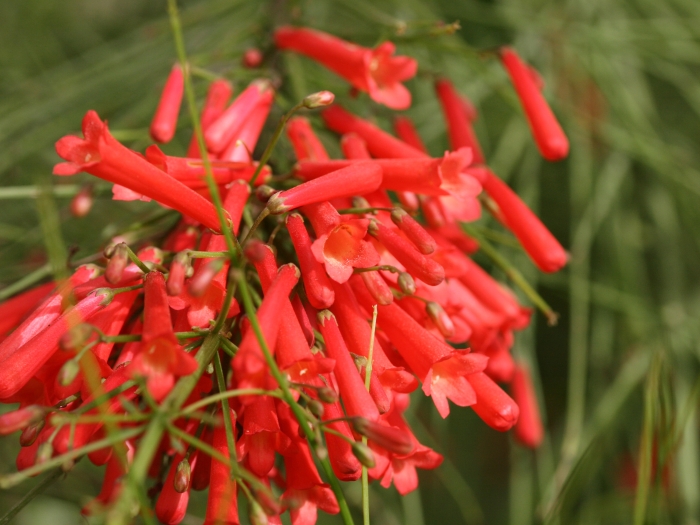Fountainbush
(Russelia equisetiformis)
Fountainbush (Russelia equisetiformis)
/
/

Dbxsoul
CC BY-SA 3.0
Image By:
Dbxsoul
Recorded By:
Copyright:
CC BY-SA 3.0
Copyright Notice:
Photo by: Dbxsoul | License Type: CC BY-SA 3.0 | License URL: https://creativecommons.org/licenses/by-sa/3.0 | Uploader: Dbxsoul | Publisher: Wikimedia Commons | Title: Russelia_equisetiformis_01.JPG | Notes: User created page with UploadWizard |























































Estimated Native Range
Summary
Russelia equisetiformis, commonly known as Fountainbush, is a semi-deciduous subshrub native to open woodlands and forest edges in Mexico and Guatemala. It typically grows to 4–5 feet (1.2–1.5 m) in height and width, with long arching branches that create a fountain-like mound. The stems and tiny oval leaves are bright green, providing a delicate texture. Fountainbush blooms profusely with small, tubular, red flowers that are highly attractive to hummingbirds and butterflies, making it a valuable plant for wildlife gardens. The flowers are showy and can bloom year-round in tropical and subtropical climates, adding continuous color to the landscape.
Fountainbush is favored for its graceful form, vibrant flowers, and ability to attract pollinators. It is commonly used in temperate gardens, as well as in containers such as window boxes, pots, and hanging planters, where its weeping habit can be showcased. Cultivars with ivory white or pink flowers are also available. For best flowering, it requires at least half a day of sunlight but can adapt to various light conditions. It can be trained as an espalier or used as a screen on balconies and terraces. While it can withstand temperatures down to −6 °C (21 °F), some sources suggest it is less cold-tolerant and should be protected or moved indoors during winter in cooler climates. Care should be taken as Russelia equisetiformis can become invasive outside its native range.CC BY-SA 4.0
Fountainbush is favored for its graceful form, vibrant flowers, and ability to attract pollinators. It is commonly used in temperate gardens, as well as in containers such as window boxes, pots, and hanging planters, where its weeping habit can be showcased. Cultivars with ivory white or pink flowers are also available. For best flowering, it requires at least half a day of sunlight but can adapt to various light conditions. It can be trained as an espalier or used as a screen on balconies and terraces. While it can withstand temperatures down to −6 °C (21 °F), some sources suggest it is less cold-tolerant and should be protected or moved indoors during winter in cooler climates. Care should be taken as Russelia equisetiformis can become invasive outside its native range.CC BY-SA 4.0
Plant Description
- Plant Type: Shrub
- Height: 2-4 feet
- Width: 3-5 feet
- Growth Rate: Rapid
- Flower Color: Red
- Flowering Season: Spring, Summer, Fall
- Leaf Retention: Semi-Deciduous
Growth Requirements
- Sun: Full Sun, Part Shade
- Water: Medium
- Drainage: Medium, Fast
Common Uses
Bee Garden, Bird Garden, Border Plant, Butterfly Garden, Deer Resistant, Erosion Control, Fire Resistant, Groundcover, Hummingbird Garden, Potted Plant, Rock Garden, Salt Tolerant, Showy Flowers, Street Planting
Natural Habitat
Open woodlands and forest edges in Mexico and Guatemala
Other Names
Common Names: Firecracker Plant, Coral Plant, Coral Fountain, Coralblow, Fountain Plant, Plante Corail, Korallblomma
Scientific Names: , Russelia equisetiformis, Russelia juncea,
GBIF Accepted Name: Russelia equisetiformis Schltdl. & Cham.